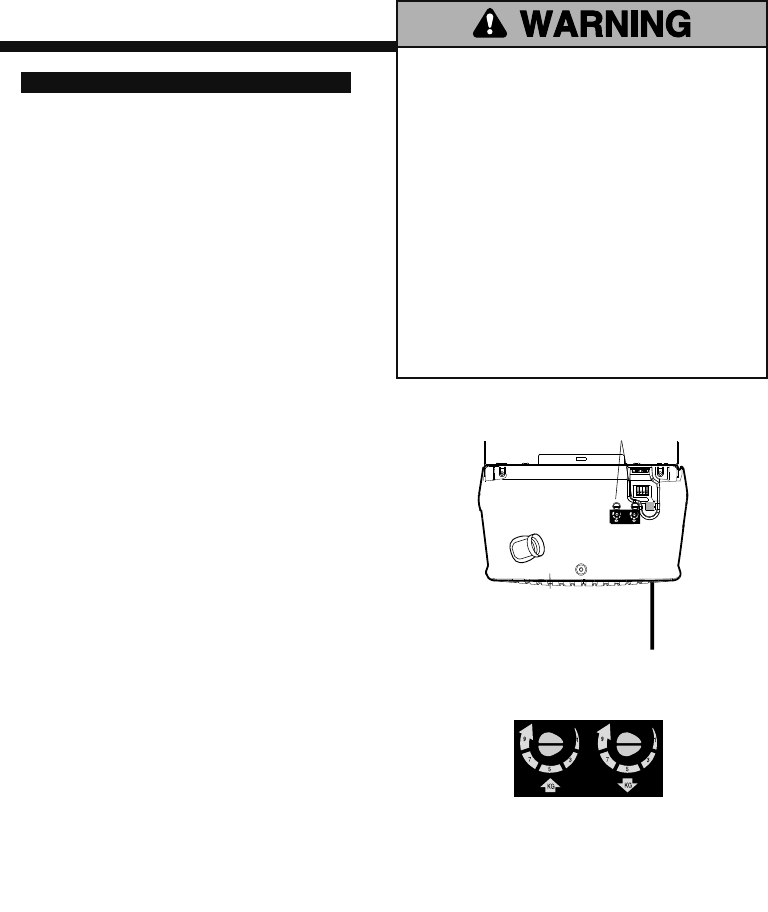
22
ADJUSTMENT STEP 2
Without a properly installed safety reversal system,
persons (particularly small children) could be
SERIOUSLY INJURED or KILLED by a closing
garage door.
• Too much force on garage door will interfere with
proper operation of safety reversal system.
• NEVER increase force beyond minimum amount
required to close garage door.
• NEVER use force adjustments to compensate for a
binding or sticking garage door.
• If one control (force or travel limits) is adjusted, the
other control may also need adjustment.
• After ANY adjustments are made, the safety reversal
system MUST be tested. Door MUST reverse on
contact with 1-1/2" (3.8 cm) high object (or 2x4 laid
fl at) on fl oor.
ADJUST THE FORCES
Force adjustment controls are located on the back panel
of the motor unit. Force adjustment settings regulate the
amount of power required to open and close the door.
If the forces are set too light, door travel may be
interrupted by nuisance reversals in the down direction
and stops in the up direction. Weather conditions can
affect the door movement, so occasional adjustment may
be needed.
The maximum force adjustment range is about 3/4 of a
complete turn. Do not force controls beyond that point.
Turn force adjustment controls with a screwdriver.
NOTE: If anything interferes with the door’s upward travel,
it will stop. If anything interferes with the door’s downward
travel (including binding or unbalanced doors), it will
reverse.
HOW AND WHEN TO ADJUST THE FORCES
1. Test the DOWN (close) force
• Grasp the door bottom when the door is about halfway
through DOWN (close) travel. The door should reverse.
Reversal halfway through down travel does not
guarantee reversal on a 1-1/2" (3.8 cm) obstruction.
See Adjustment Step 3, page 23. If the door is hard to
hold or doesn’t reverse, decrease the DOWN (close)
force by turning the control counterclockwise. Make
small adjustments until the door reverses normally.
After each adjustment, run the opener through a
complete cycle.
• If the door reverses during the down (close) cycle
and the opener lights aren’t fl ashing, increase DOWN
(close) force by turning the control clockwise. Make
small adjustments until the door completes a close
cycle. After each adjustment, run the opener through a
complete travel cycle. Do not increase the force beyond
the minimum amount required to close the door.
2. Test the UP (open) force
• Grasp the door bottom when the door is about halfway
through UP (open) travel. The door should stop. If
the door is hard to hold or doesn’t stop, decrease UP
(open) force by turning the control counterclockwise.
Make small adjustments until the door stops easily
and opens fully. After each adjustment, run the opener
through a complete travel cycle.
• If the door doesn’t open at least 5 feet (1.5 m),
increase UP (open) force by turning the control
clockwise. Make small adjustments until door opens
completely. Readjust the UP limit if necessary. After
each adjustment, run the opener through a complete
travel cycle.
Force Settings:
1 = Lowest Force
9 = Maximum Force
Force Adjustment Controls
Back Side Panel
Open Force Close Force
FORCE ADJUSTMENT LABEL


















